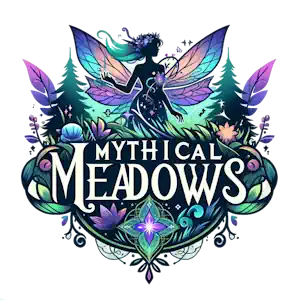Imagine creating a miniature world filled with enchantment and magic right in your own backyard. That’s the essence of a Fairy Garden – a charming and whimsical space adorned with intricately designed accessories, lush greenery, and tiny fairy figurines. These delightful gardens transport you to a realm where fairies play, where imagination takes flight, and where beauty and wonder flourish.
In this article, we will explore the captivating world of Fairy Gardens, uncovering their origins, sharing tips for creating your own, and revealing the sheer joy they bring to both young and old alike. So, get ready to unlock the door to an enchanting world as we unveil what lies within a Fairy Garden.
Definition of Fairy Garden
A fairy garden is a miniature garden that portrays a whimsical and enchanted world. It is a tiny, carefully curated space that is designed to attract fairies and create a magical ambiance. The concept typically includes miniature plants, accessories, and decorations that bring the fairy garden to life. It is a beautiful way to add a touch of fantasy and creativity to your indoor or outdoor space.
Origin of Fairy Gardens
Fairy gardens are believed to have originated in Europe during the Victorian era. Inspired by folklore and the idea of tiny fairy dwellings, people started creating these miniature gardens as a way to express their imagination and create a connection with the mystical world. These enchanted gardens gained popularity in recent years as a form of creative expression and a way to escape the pressures of the modern world.
Choosing a Fairy Garden Container
Selecting the right container is an important step in creating your fairy garden. You want a container that suits your desired theme and provides enough space for your desired plants and accessories. Some popular options include wooden barrels, ceramic pots, or even old teapots or birdhouses. Make sure the container has proper drainage to prevent water from pooling and damaging your plants.
Consider the size and shape of the container based on the plants and accessories you plan to include. If you want to create a lush and elaborate garden, a larger container would be suitable. However, if you prefer a more compact and minimalist design, a smaller container can work just as well. Ultimately, the container should serve as a canvas for your creativity and enhance the overall aesthetic of your fairy garden.
Selecting Miniature Plants
Choosing the right plants is crucial in creating a thriving and visually appealing fairy garden. Opt for small plants that won’t outgrow the container and overshadow other elements of the garden. Moss and succulents are popular choices due to their compact size and low maintenance requirements. They also add a touch of greenery and create a lush, fairy-like atmosphere. Sedum is another great choice.
To add visual interest and variety, consider selecting plants with different colors and textures. Mixing plants with vibrant flowers, delicate leaves, and interesting shapes can create a stunning and diverse fairy garden. Additionally, look for plants that resemble trees, shrubs, or flowers in miniature form. These miniatures can mimic a realistic landscape and transport you into the magical world of fairies.
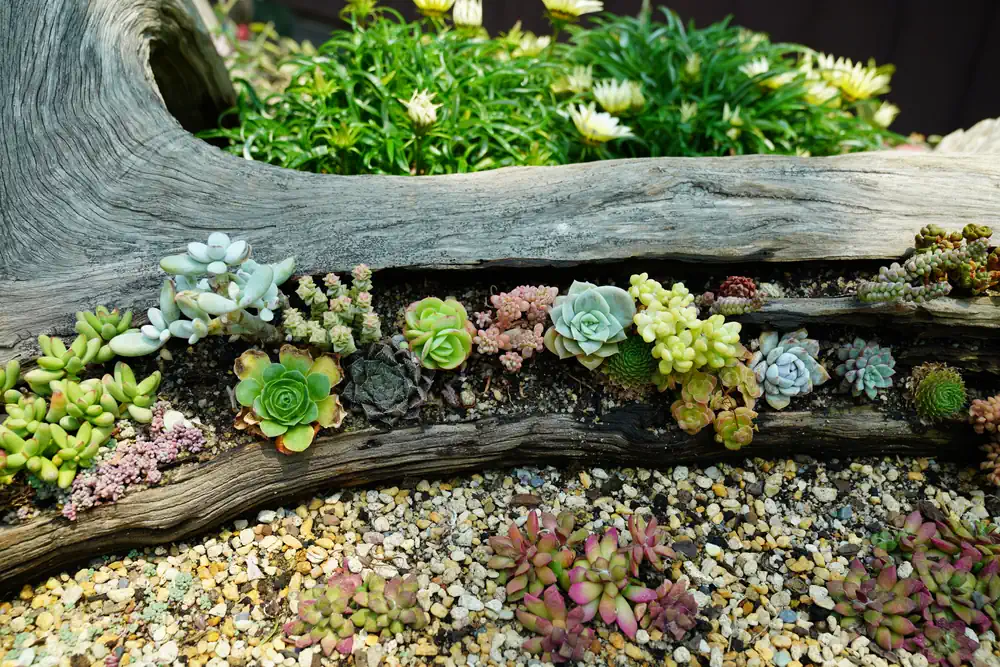
Ideas for Fairy Garden Accessories
In addition to plants, accessories can help bring your fairy garden to life. Here are some popular accessory ideas to consider:
Miniature Furniture:
Tiny benches, tables, and chairs can create cozy seating areas for your fairy friends. These miniature pieces of furniture add a whimsical touch to your garden and provide a place for fairies to rest and enjoy their surroundings.
Fairy Figurines and Gnomes:
No fairy garden is complete without the presence of fairies and gnomes. These tiny figurines add charm and personality to your garden. Place them strategically among the plants and accessories to create a sense of magical inhabitants.
Fences, Gates, and Bridges:
Miniature fences, gates, and bridges can help define the space within your fairy garden. They can add structure and create visual interest. These accessories can be made from a variety of materials, such as wood, wire, or even pebbles.

Decorative Stones, Pebbles, and Pathways:
Stones, pebbles, and pathways serve both a functional and decorative purpose in your fairy garden. They can create a sense of wander and guide the fairies through the enchanting landscape. You can use various colors and textures to enhance the overall aesthetic.
Miniature Water Features:
Water features such as ponds or fountains can add an element of tranquility and serenity to your fairy garden. The sound of trickling water can create a peaceful atmosphere and attract fairies looking for a place to refresh themselves. Be sure to choose small-scale water features that fit well within your container.
Creating a Fairy Garden Theme
Choosing a theme for your fairy garden helps to create a cohesive and enchanting environment. You can select a theme based on your interests or even a specific fairy tale. Here are some ideas for fairy garden themes:
Beach Theme:
Create a miniature beach paradise with sandy pathways, seashell decorations, and tiny beach chairs. Incorporate plants that resemble coastal grasses and small succulents that thrive in sandy conditions. The beach theme is perfect for those who love the ocean and want to bring a coastal vibe to their fairy garden.
Woodland Theme:
Bring the forest to life with a woodland-themed fairy garden. Include miniature trees, toadstools, and woodland creatures like deer or rabbits. Use moss and ferns to mimic the forest floor, and add tiny mushrooms for an extra touch of whimsy. A woodland theme is great for nature lovers and those who want to create a magical forest retreat.
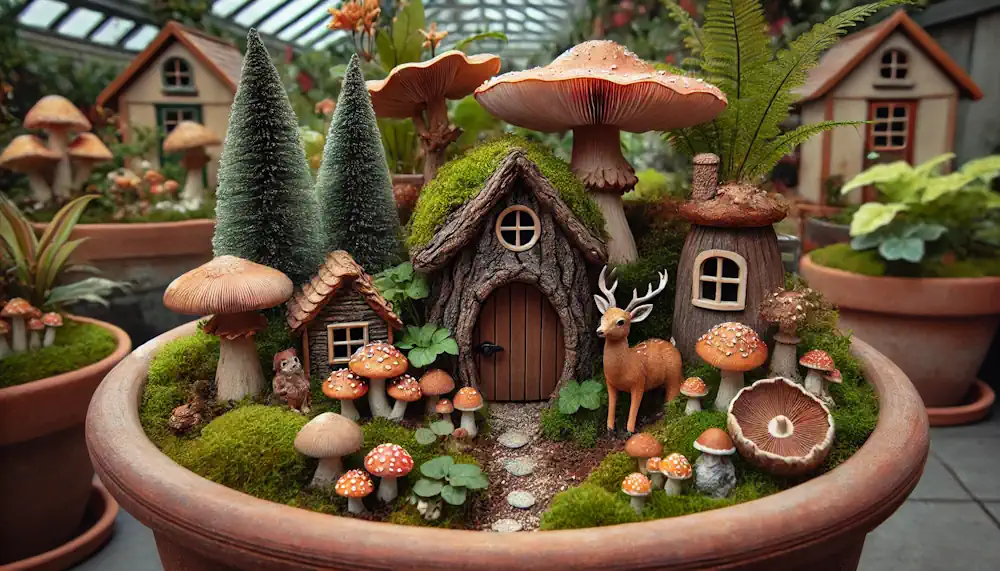
Fairy Castle Theme:
Transform your fairy garden into a majestic castle fit for royalty. Incorporate miniature castle towers, drawbridges, and flags. Use plants with vibrant flowers and intricate leaves to give the garden a regal touch. A fairy castle theme is perfect for those who love the idea of a fairy tale kingdom and want to create a grand and majestic atmosphere.
When choosing a theme, ensure that all elements of the garden, including plants and accessories, are consistent with the chosen theme. By maintaining a cohesive theme, you can create a truly immersive and magical experience within your fairy garden.
Designing the Layout of the Fairy Garden
Designing the layout of your fairy garden is a creative and exciting process. Consider the size and shape of the container to determine the layout. Place taller plants towards the back and shorter plants towards the front to create a sense of depth and perspective. This will make your fairy garden visually pleasing and more natural-looking.
Arrange accessories and decorations in a way that complements the plants and enhances the chosen theme. Experiment with different arrangements until you achieve a layout that is visually appealing and brings your fairy garden to life. Consider creating different levels or layers within the garden by using rocks or other materials to add variation and interest.
Pay attention to the proportion and balance of elements. The size of the plants and accessories should be in harmony with one another and the overall size of the container. Avoid overcrowding the space, as it can make the garden look cluttered and chaotic. By carefully designing the layout, you can create a magical and harmonious fairy garden that is visually stunning.
Maintaining a Fairy Garden
Like any other garden, a fairy garden requires maintenance to keep it healthy and beautiful. Here are some tips for maintaining your fairy garden:
Regularly water and monitor the plants to keep them healthy.
Different plants have different water requirements, so be sure to research and follow the specific care instructions for the plants in your fairy garden. Overwatering can lead to root rot, while underwatering can cause the plants to wither and die. Strike a balance to ensure the well-being of your plants.
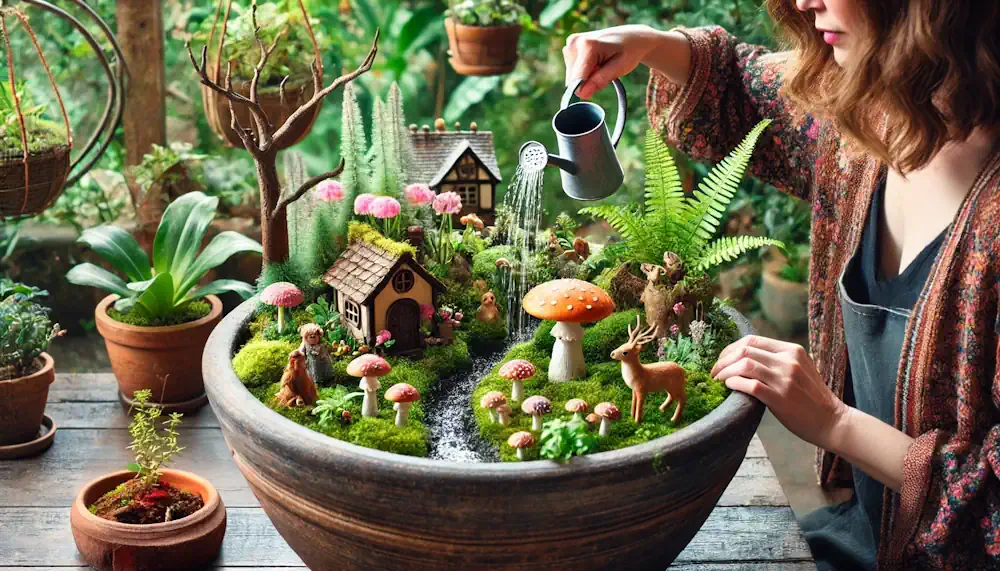
Trim or prune plants as necessary to maintain their shape and size.
As your plants grow, they may need some grooming to prevent them from overpowering the garden or obstructing the view of accessories. Regular trimming or pruning will help keep the plants in control and maintain the desired aesthetic of your fairy garden.
Remove any fallen leaves or debris from the garden.
Leaves, twigs, and other debris can accumulate in your fairy garden over time and detract from its beauty. Regularly clean and remove any fallen leaves or debris to keep the garden looking neat and tidy.
Replace or repair damaged accessories or decorations as needed.
Weather conditions or accidental mishaps can damage your accessories or decorations. If any of them break or become worn, replace or repair them to maintain the overall magical ambiance of your fairy garden.
By regularly maintaining your fairy garden, you can ensure its longevity and keep it looking its best for years to come.
Attracting Fairies to Your Garden
The ultimate goal of a fairy garden is to attract fairies and create a welcoming environment for them. Here are some tips to make your garden more appealing to these magical creatures.
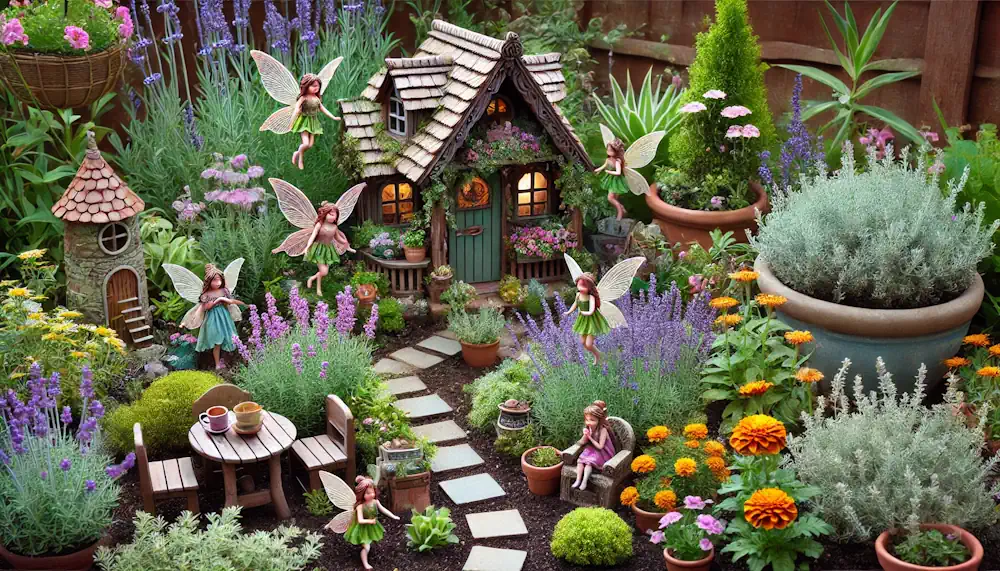
Provide shelter for fairies, such as miniature houses or hidden nooks.
Creating tiny shelters for fairies will give them a cozy place to rest and call home. You can use miniature houses, hollow tree stumps, or even build small fairy villages within your garden.
Include natural elements like rocks, shells, or twigs to create a welcoming environment.
Fairies are most at home in nature, so incorporating natural materials in your fairy garden will make it more inviting to them. Use rocks, shells, twigs, or pebbles to create miniature pathways, seating areas, or other natural elements.
Add fairy-friendly plants like lavender, thyme, or marigold.
Certain plants are believed to be attractive to fairies. Lavender, thyme, and marigold are commonly associated with fairies and can help create an enticing atmosphere. These plants also add a lovely scent and vibrant colors to your fairy garden.
Create a calm and peaceful atmosphere by adding wind chimes or gentle music.
Fairies are often associated with tranquility and peace. Adding wind chimes or playing soft, gentle music in your garden can create a soothing atmosphere that fairies are drawn to.
By incorporating these elements into your fairy garden, you can increase the chances of attracting some magical visitors and make your garden feel like a true haven for fairies.
Benefits of Having a Fairy Garden
Creating and maintaining a fairy garden offers numerous benefits, beyond the joy of interacting with a whimsical and enchanted space. Here are some of the key advantages:
Promotes creativity and imagination.
Building a fairy garden allows you to tap into your creativity and imagination. It gives you the opportunity to design and construct a miniature world that reflects your personality and interests. The process of creating a unique fairy garden can also be a therapeutic and relaxing activity.
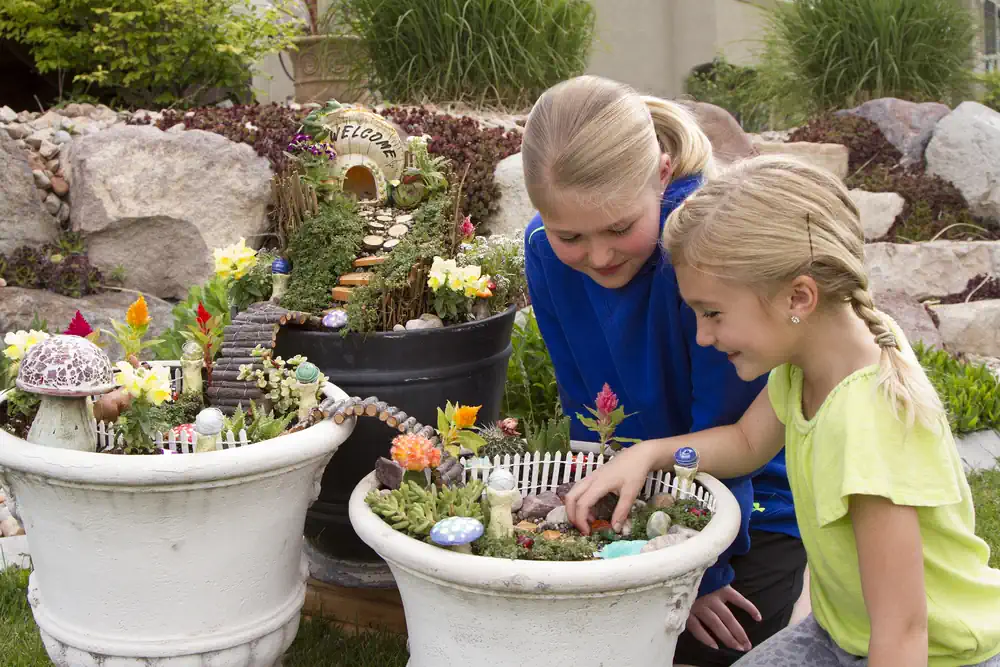
Serves as a stress-relieving and therapeutic activity.
Gardening, in general, has been proven to have therapeutic benefits for mental health. Spending time in nature, tending to plants, and creating a peaceful oasis can help reduce stress and anxiety levels. The act of caring for your fairy garden can provide a calming and meditative experience, allowing you to unwind and escape the pressures of everyday life.
Adds beauty and charm to any indoor or outdoor space.
A well-designed and carefully curated fairy garden can be a stunning centerpiece in your home or garden. It adds a touch of elegance and whimsy to any space, creating a focal point that sparks joy and conversation. Whether you choose to display your fairy garden indoors or outdoors, it will undoubtedly bring beauty and charm to your surroundings.
Brings a sense of magic and enchantment to your surroundings.
Fairy gardens have a way of transporting you to a world of magic and enchantment. By creating a space that evokes wonder and imagination, you can infuse a sense of childlike joy into your everyday life. The presence of a fairy garden can remind you to embrace the magical moments and appreciate the beauty that surrounds you.
In conclusion, a fairy garden is a small but mighty source of joy and creativity. It originated in the Victorian era and has gained popularity as a form of creative expression in recent years. By carefully selecting a container, choosing the right plants and accessories, and maintaining the garden’s health, you can create a magical space that attracts fairies and brings beauty and enchantment to your surroundings. So why not bring a touch of whimsy into your life and embark on the journey of creating your own fairy garden? The possibilities are endless, and the rewards are truly magical.
